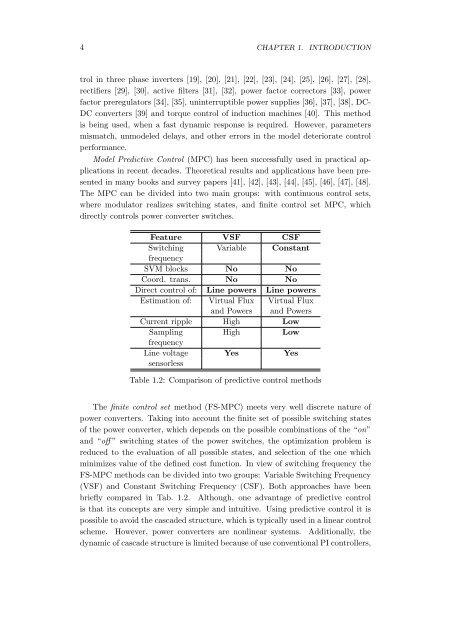Predictive Control of Three Phase AC/DC Converters
Predictive Control of Three Phase AC/DC Converters
Predictive Control of Three Phase AC/DC Converters
You also want an ePaper? Increase the reach of your titles
YUMPU automatically turns print PDFs into web optimized ePapers that Google loves.
4 CHAPTER 1. INTRODUCTION<br />
trol in three phase inverters [19], [20], [21], [22], [23], [24], [25], [26], [27], [28],<br />
rectifiers [29], [30], active filters [31], [32], power factor correctors [33], power<br />
factor preregulators [34], [35], uninterruptible power supplies [36], [37], [38], <strong>DC</strong>-<br />
<strong>DC</strong> converters [39] and torque control <strong>of</strong> induction machines [40]. This method<br />
is being used, when a fast dynamic response is required. However, parameters<br />
mismatch, unmodeled delays, and other errors in the model deteriorate control<br />
performance.<br />
Model <strong>Predictive</strong> <strong>Control</strong> (MPC) has been successfully used in practical applications<br />
in recent decades. Theoretical results and applications have been presented<br />
in many books and survey papers [41], [42], [43], [44], [45], [46], [47], [48].<br />
The MPC can be divided into two main groups: with continuous control sets,<br />
where modulator realizes switching states, and finite control set MPC, which<br />
directly controls power converter switches.<br />
Feature VSF CSF<br />
Switching Variable Constant<br />
frequency<br />
SVM blocks No No<br />
Coord. trans. No No<br />
Direct control <strong>of</strong>: Line powers Line powers<br />
Estimation <strong>of</strong>: Virtual Flux Virtual Flux<br />
and Powers and Powers<br />
Current ripple High Low<br />
Sampling High Low<br />
frequency<br />
Line voltage Yes Yes<br />
sensorless<br />
Table 1.2: Comparison <strong>of</strong> predictive control methods<br />
The finite control set method (FS-MPC) meets very well discrete nature <strong>of</strong><br />
power converters. Taking into account the finite set <strong>of</strong> possible switching states<br />
<strong>of</strong> the power converter, which depends on the possible combinations <strong>of</strong> the “on”<br />
and “<strong>of</strong>f ” switching states <strong>of</strong> the power switches, the optimization problem is<br />
reduced to the evaluation <strong>of</strong> all possible states, and selection <strong>of</strong> the one which<br />
minimizes value <strong>of</strong> the defined cost function. In view <strong>of</strong> switching frequency the<br />
FS-MPC methods can be divided into two groups: Variable Switching Frequency<br />
(VSF) and Constant Switching Frequency (CSF). Both approaches have been<br />
briefly compared in Tab. 1.2. Although, one advantage <strong>of</strong> predictive control<br />
is that its concepts are very simple and intuitive. Using predictive control it is<br />
possible to avoid the cascaded structure, which is typically used in a linear control<br />
scheme. However, power converters are nonlinear systems. Additionally, the<br />
dynamic <strong>of</strong> cascade structure is limited because <strong>of</strong> use conventional PI controllers,
















![[TCP] Opis układu - Instytut Sterowania i Elektroniki Przemysłowej ...](https://img.yumpu.com/23535443/1/184x260/tcp-opis-ukladu-instytut-sterowania-i-elektroniki-przemyslowej-.jpg?quality=85)
